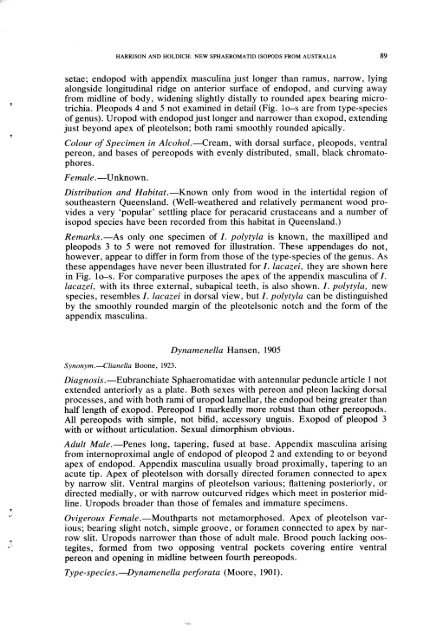Download PDF as one large file
Download PDF as one large file
Download PDF as one large file
You also want an ePaper? Increase the reach of your titles
YUMPU automatically turns print PDFs into web optimized ePapers that Google loves.
HARRISON AND HOLDICH: NEW SPHAEROMATID ISOPODS FROM AUSTRALIA 89<br />
setae; endopod with appendix m<strong>as</strong>culina just longer than ramus, narrow, lying<br />
alongside longitudinal ridge on anterior surface of endopod, and curving away<br />
from midline of body, widening slightly distally to rounded apex bearing microtrichia.<br />
Pleopods 4 and 5 not examined in detail (Fig. lo-s are from type-species<br />
of genus). Uropod with endopod just longer and narrower than exopod, extending<br />
just beyond apex of pleotelson; both rami smoothly rounded apically.<br />
Colour of Specimen in Alcohol.—Cream, with dorsal surface, pleopods, ventral<br />
pereon, and b<strong>as</strong>es of pereopods with evenly distributed, small, black chromatophores.<br />
Female. —Unknown.<br />
Distribution and Habitat.—Known only from wood in the intertidal region of<br />
southe<strong>as</strong>tern Queensland. (Well-weathered and relatively permanent wood provides<br />
a very 'popular' settling place for peracarid crustaceans and a number of<br />
isopod species have been recorded from this habitat in Queensland.)<br />
Remarks.—As only <strong>one</strong> specimen of /. polytyla is known, the maxiUiped and<br />
pleopods 3 to 5 were not removed for illustration. These appendages do not,<br />
however, appear to differ in form from those of the type-species of the genus. As<br />
these appendages have never been illustrated for /. lacazei, they are shown here<br />
in Fig. lo-s. For comparative purposes the apex of the appendix m<strong>as</strong>culina of/.<br />
lacazei, with its three external, subapical teeth, is also shown. /. polytyla, new<br />
species, resembles /. lacazei in dorsal view, but /. polytyla can be distinguished<br />
by the smoothly rounded margin of the pleotelsonic notch and the form of the<br />
appendix m<strong>as</strong>culina.<br />
Synonym.—Clianella Bo<strong>one</strong>, 1923.<br />
Dynamenella Hansen, 1905<br />
Diagnosis.—Eubranchiate Sphaeromatidae with antennular peduncle article 1 not<br />
extended anteriorly <strong>as</strong> a plate. Both sexes with pereon and pleon lacking dorsal<br />
processes, and with both rami of uropod lamellar, the endopod being greater than<br />
half length of exopod. Pereopod 1 markedly more robust than other pereopods.<br />
All pereopods with simple, not bifid, accessory unguis. Exopod of pleopod 3<br />
with or without articulation. Sexual dimorphism obvious.<br />
Adult Male.—Penes long, tapering, fused at b<strong>as</strong>e. Appendix m<strong>as</strong>culina arising<br />
from internoproximal angle of endopod of pleopod 2 and extending to or beyond<br />
apex of endopod. Appendix m<strong>as</strong>culina usually broad proximally, tapering to an<br />
acute tip. Apex of pleotelson with dorsally directed foramen connected to apex<br />
by narrow slit. Ventral margins of pleotelson various; flattening posteriorly, or<br />
directed medially, or with narrow outcurved ridges which meet in posterior midline.<br />
Uropods broader than those of females and immature specimens.<br />
Ovigerous Female.—Mouthparts not metamorphosed. Apex of pleotelson various;<br />
bearing slight notch, simple groove, or foramen connected to apex by narrow<br />
slit. Uropods narrower than those of adult male. Brood pouch lacking oostegites,<br />
formed from two opposing ventral pockets covering entire ventral<br />
pereon and opening in midline between fourth pereopods.<br />
Type-species.—Dynamenella perforata (Moore, 1901).

















